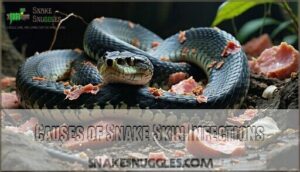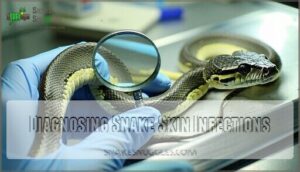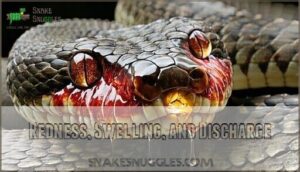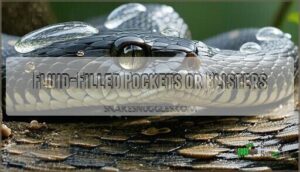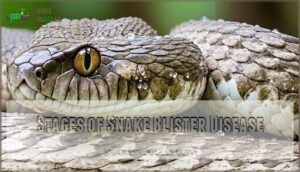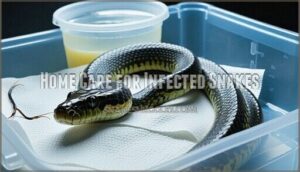This site is supported by our readers. We may earn a commission, at no cost to you, if you purchase through links.
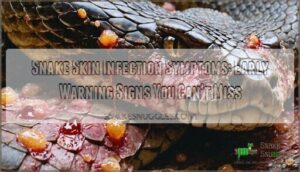
These infections often start small but can escalate quickly. Watch for ruptured blisters that develop into weeping sores, soft or pitted areas on the shell, and reddish-brown lesions with fungal growths.
Your snake might also show loss of appetite and weight loss as the infection progresses. Early detection is essential since untreated infections can lead to septicemia and organ damage.
The key lies in understanding what each symptom means and when immediate veterinary intervention becomes necessary.
Table Of Contents
- Key Takeaways
- Common Snake Skin Infections
- Causes of Snake Skin Infections
- Diagnosing Snake Skin Infections
- Symptoms of Snake Skin Infections
- Stages of Snake Blister Disease
- Snake Fungal Disease and Its Appearance
- Treating Snake Skin Infections
- Home Care for Infected Snakes
- Preventing Snake Skin Infections
- Complications of Untreated Snake Skin Infections
- Frequently Asked Questions (FAQs)
- How to treat snake skin infection?
- What does a skin infection look like on a snake?
- How to treat bacterial infection in snakes?
- What does snake skin rot look like?
- How to tell if a snake has an infection?
- What is the early stage of snake blister disease?
- How do you treat a snake skin infection?
- How do you know if a snake is infected?
- What does snake fungal disease look like?
- Can snake skin infections spread to humans?
- Conclusion
Key Takeaways
- Watch for visual red flags – You’ll spot infections through red, swollen patches, fluid-filled blisters, pus-filled bumps, and crusty lesions that can quickly escalate from minor irritation to serious disease.
- Don’t ignore behavioral changes – Loss of appetite, weight loss, and lethargy often accompany skin infections and signal your snake’s immune system is fighting a battle it might lose without help.
- Act fast to prevent life-threatening complications – Untreated skin infections can progress to septicemia, organ damage, and respiratory failure within days, making early intervention crucial for your snake’s survival.
- Maintain proper husbandry as your first defense – Control humidity levels, keep enclosures clean, and provide balanced nutrition to prevent most skin infections before they start, saving you from costly veterinary emergencies.
Common Snake Skin Infections
You’ll recognize snake skin infections by their distinct visual and behavioral symptoms that develop progressively over time.
These conditions range from localized abscesses requiring drainage to severe systemic diseases like SCUD that threaten your snake’s life, including conditions that can be considered systemic.
Abscesses and Pus-Filled Cavities
Snake abscesses create pus-filled cavities that demand immediate attention for proper infection control.
These bacterial infections require professional cavity drainage and targeted abscess treatment to prevent complications.
Effective wound healing depends on maintaining sterile conditions and following veterinary protocols for ideal recovery.
- Pus formation indicates active bacterial infection requiring immediate veterinary intervention
- Cavity drainage must be performed by professionals to prevent tissue damage
- Infection control involves antibiotic therapy and proper wound management techniques
- Wound healing requires clean, dry environments with controlled temperature and humidity
- Abscess treatment may include surgical debridement of dead tissue and ongoing monitoring
Blister Disease and Fluid-Filled Pockets
Blisters appear as fluid-filled pockets on your snake’s skin when environmental conditions create the perfect storm.
These lesions form when excessive humidity, poor hygiene, or inadequate environments stress your pet’s immune system. Understanding snake skin infections is essential for early detection and treatment.
- Blister formation starts with fluid accumulation under scales from bacterial infections
- Skin lesions develop as infection control breaks down in contaminated substrates
- Scale damage progresses without proper treatment, leading to permanent scarring
Scale Rot and Ruptured Blisters
Ruptured blisters signal advanced blister disease requiring immediate attention.
You’ll notice raw, weeping sores where protective scales once existed, creating perfect entry points for fungal infections.
Scale damage appears as reddish inflammation with exposed underlying tissue.
These skin lesions demand prompt blister care using antifungal treatments and improved hygiene.
Without proper wound healing protocols, scale rot progresses rapidly.
Monitor affected areas daily and adjust humidity levels immediately to prevent further reptile skin infections from developing, which can lead to fungal infections.
Shell Rot and Soft or Pitted Shells
Between the lines of healthy shell care and devastating disease lies shell rot, where soft shells signal serious trouble ahead.
You’ll notice shells becoming pitted, mushy, or developing dark spots that spread rapidly across your snake’s protective armor.
- Shell Care requires daily inspection for early detection of abnormalities
- Pitted Shells indicate bacterial invasion requiring immediate veterinary intervention
- Soft Shell texture suggests advanced infection compromising structural integrity
- Rot Prevention depends on controlling humidity levels below 70 percent consistently
Septicemic Cutaneous Ulcerative Disease (SCUD)
SCUD represents one of the most serious bacterial infections you’ll encounter in snakes.
SCUD spreads through your snake’s bloodstream, turning skin wounds into life-threatening septicemia within days
This condition involves bacterial invasion of the bloodstream, creating painful skin ulcers and systemic infection.
Early SCUD symptoms include red, swollen lesions that rapidly spread across your snake’s body.
Without prompt wound care and infection control, septicemia develops quickly.
Bacterial infections like ulcerative dermatitis can progress to this life-threatening stage within days.
Professional veterinary treatment becomes absolutely necessary once snake skin infection reaches SCUD severity levels.
Causes of Snake Skin Infections
Understanding what causes snake skin infections helps you protect your pet from serious health complications.
Poor husbandry conditions, weakened immunity, and environmental factors create the perfect storm for dangerous bacterial and fungal infections.
Bacteria and Fungi in Dirty or Humid Environments
Environmental factors create breeding grounds for snake skin infection when you neglect proper humidity control.
Dirty substrates harbor harmful bacteria like Pseudomonas and Aeromonas, while excessive moisture promotes fungal growth of Ophidiomyces ophiodiicola.
Bacterial spread and fungal infection thrive in dirty enclosures, causing skin lesions that progress from minor irritation to severe ulcerative disease requiring immediate veterinary intervention.
Understanding snake fungal disease is essential for preventing the spread of infection in snake populations.
Weakened Immune System Due to Poor Nutrition
Poor nutrition creates a perfect storm for snake health issues.
When your snake doesn’t receive adequate vitamins, minerals, and proteins, malnutrition effects compromise its immune system defenses.
Nutrient deficiency prevents proper antibody production and cellular repair.
Meeting your snake’s specific dietary needs strengthens disease resistance, while neglecting nutrition invites health consequences including increased susceptibility to snake skin infection symptoms.
Skin or Shell Injuries and Increased Infection Risk
Physical injuries create direct pathways for pathogens to enter your snake’s body.
Trauma Response requires immediate Wound Care to prevent snake skin infection.
Rough handling, sharp substrate, or cage furniture can cause Skin Lesions and Shell Damage.
These breaks in reptile skin compromise natural barriers, making Infection Control critical for preventing serious skin symptoms.
Inadequate Sanitation and Bacterial Growth
Dirty enclosures become breeding grounds where bacterial spores multiply rapidly, creating dangerous conditions for your snake.
When you skip regular cleaning routines, harmful pathogens accumulate in substrate and water bowls, leading to serious bacterial infection and painful skin lesions that require immediate veterinary attention. Understanding fungal disease causes is essential for preventing such infections.
- Daily spot-cleaning removes waste before bacterial contamination spreads
- Weekly deep-cleaning with proper sanitation protocols eliminates hidden pathogens
- Substrate replacement prevents fungal contamination from establishing permanent colonies
Excessive Humidity and Microorganism Growth
Excessive humidity control becomes critical when moisture levels exceed 60-70%, creating perfect conditions for bacterial colonies and fungal spores to multiply rapidly.
Poor moisture management transforms your snake’s habitat into a breeding ground where microbe growth accelerates, leading to bacterial infection and fungal infection.
These pathogens target vulnerable areas, causing skin lesions that progress into serious snake skin infection symptoms requiring immediate veterinary attention.
Diagnosing Snake Skin Infections
When you suspect your snake has a skin infection, you’ll need proper diagnostic methods to confirm the problem and identify the specific pathogen.
Veterinary examination combines visual assessment, laboratory testing, and physical inspection to determine the exact cause and severity of the infection.
Veterinary Examination and Clinical Signs
Your veterinarian will conduct a thorough clinical examination to identify snake skin infection symptoms through systematic observation.
Professional assessment reveals critical diagnostic information that determines appropriate treatment protocols.
- Skin lesions examination identifies infection patterns, texture changes, and distribution across body segments
- Swelling signs assessment detects inflammation, fluid accumulation, and tissue abnormalities requiring immediate attention
- Clinical tests including cultures and cytology provide definitive pathogen identification for targeted therapy
- Veterinary care protocols guarantee accurate infection diagnosis through thorough physical and behavioral evaluations
Blood Work and Internal Infection Detection
Blood tests reveal critical infection markers that indicate internal progression beyond surface symptoms.
Elevated white blood cell counts signal systemic infection, while abnormal liver enzymes suggest organ damage.
These diagnostic tools help veterinarians determine treatment urgency and prognosis.
Laboratory results guide antibiotic selection and monitor treatment effectiveness, preventing life-threatening complications.
Accurate diagnosis often requires understanding of reptile health issues to identify the root cause of infection, and ensure a proper diagnosis.
Antibiotic Sensitivity Testing for Bacterial Infections
Antibiotic sensitivity testing identifies which medications effectively target your snake’s specific bacterial infection.
This laboratory procedure determines Bacterial Resistance patterns and guides ideal Antibiotic Therapy selection, improving Treatment Outcomes substantially.
Antibiotic Sensitivity Testing offers three key advantages:
- Bacterium Identification – Pinpoints exact bacterial species causing Snake Skin Infection Symptoms
- Antibiotic Efficacy assessment – Reveals which treatments work against Bacterial Dermatitis
- Infection Control optimization – Prevents treatment failures and reduces recovery time
Physical Exam and Shell or Skin Inspection
Physical examination reveals critical details through systematic skin inspection and shell check.
Your visual exam should focus on lesion evaluation, identifying snake skin infection symptoms like discolored scales, abnormal texture, or tissue assessment abnormalities.
Look for snake fungal disease indicators: crusty patches, swelling, or reptile skin lesions that suggest deeper skin infection concerns requiring immediate attention.
Symptoms of Snake Skin Infections
You’ll recognize snake skin infection symptoms through visible changes in your pet’s appearance and behavior.
Early detection of redness, swelling, discharge, blisters, or appetite loss helps prevent serious complications like septicemia.
Redness, Swelling, and Discharge
Redness, swelling, and discharge are classic Infection Signs you can’t ignore.
These skin lesions often point to underlying skin infection and demand prompt Wound Care.
Swelling Causes can range from bacteria to fungi, while discharge treatment depends on the type and consistency.
Always monitor changes in color or odor—think of it as your snake’s way of waving a red flag.
Fluid-Filled Pockets or Blisters
Fluid-filled bumps on your snake’s skin signal blister disease, a condition requiring immediate attention.
These pocket-like formations often appear as raised areas containing clear or cloudy fluid.
- Blister formation typically occurs on belly scales from excessive humidity
- Skin lesions develop when fluid accumulation weakens tissue integrity
- Pocket infections emerge when bacteria invade fluid-filled blisters
- Scale rot follows if blister disease progresses untreated
Understanding skin infection causes is essential for effective treatment and prevention of such conditions.
Pus-Filled Cavities or Abscesses
While blisters signal surface trouble, abscesses represent deeper bacterial warfare beneath your snake’s skin.
These pus-filled cavities demand immediate abscess treatment through veterinary pus removal and proper wound care. Antibiotic use becomes critical for infection control, preventing ulcerative dermatitis from spreading throughout tissues.
| Abscess Stage | Visual Signs | Treatment Approach |
|---|---|---|
| Early | Small, firm bumps | Topical antibiotics |
| Moderate | Visible pus buildup | Surgical drainage |
| Severe | Open, weeping wounds | Systemic antibiotics |
Bacterial infections creating these snake skin infection symptoms won’t resolve alone—professional intervention guarantees your reptile’s recovery.
Loss of Appetite and Weight Loss
Appetite changes often signal deeper health issues when your snake starts refusing meals consistently.
These infection symptoms frequently pair with visible weight decline, creating a concerning pattern that snake owners shouldn’t ignore.
When fungal infection or bacterial illness takes hold, your pet’s metabolism shifts dramatically.
Here are five warning signs linking loss of appetite to snake skin infection:
- Missed feedings spanning 2-3 consecutive meal times without environmental stressors
- Visible weight decline with prominent spine or hip bones becoming noticeable
- Poor nutrition absorption causing weakness despite previous healthy eating patterns
- Weak immune responses making recovery slower and infections more persistent
- Malabsorption issues leading to regurgitation or unusual digestive behaviors
This combination creates a dangerous cycle where infection weakens appetite, while inadequate nutrition compromises the body’s ability to fight off pathogens effectively.
Stages of Snake Blister Disease
Snake blister disease progresses through distinct stages that you can identify with careful observation. Understanding these stages helps you provide timely treatment and prevent serious complications from developing.
Early Stage With Small Blisters
Small blisters signal the beginning stages of snake skin infection, requiring immediate attention. These tiny fluid-filled bumps often appear before more serious complications develop.
- Monitor for blister formation on ventral scales and skin surfaces
- Document skin lesions with photos to track progression patterns
- Assess environmental factors that promote bacterial growth and fungal infections
- Schedule veterinary consultation for proper wound care and treatment planning
Advanced Stage With Ruptured Blisters and Scale Rot
Advanced snake skin infection transforms your pet’s condition dramatically.
Ruptured blisters expose raw tissue, creating perfect entry points for bacteria.
Scale rot develops when skin lesions worsen, showing brown or greenish discoloration.
Fungal infections often colonize these wounds, producing crusty scabs.
Advanced symptoms include persistent discharge, missing scales, and skin erosion that heals poorly without veterinary intervention.
Severe Stage With Shell Rot and SCUD
When severe infection takes hold, your snake faces life-threatening complications that demand immediate veterinary intervention and aggressive treatment protocols.
- Shell rot symptoms: Soft, pitted shells with foul-smelling discharge indicate deep tissue damage requiring surgical debridement
- SCUD progression: Septicemic cutaneous ulcerative disease spreads through bloodstream, causing painful ulcers and organ failure
- Advanced treatment: Injectable antibiotics, antifungal medications, and supportive care become essential for recovery
Snake Fungal Disease and Its Appearance
Snake Fungal Disease creates distinctive visual markers that you’ll recognize once you know what to look for.
The infection produces characteristic reddish-brown lesions, white or yellowish fungal growths, and progressive skin erosion that can help you identify this serious condition early.
Reddish-Brown Lesions on The Skin or Shell
When reddish-brown lesions appear on your snake’s skin or shell, you’re looking at a telltale sign of snake fungal disease.
These crusty, thickened patches typically show up on the belly where your snake contacts contaminated substrate.
The lesions start small but can expand into ulcerated areas with severe crusting, making movement painful and potentially life-threatening if left untreated.
White or Yellowish Fungal Growths
When you spot white or yellowish fungal growths on your snake’s skin, you’re looking at a classic fungal infection symptom.
These white growths appear as cotton-like patches or crusty formations, signaling snake fungal infection.
The yellowish discoloration often accompanies skin lesions, creating a distinctive appearance.
Early fungus treatment prevents progression to severe fungal disease complications.
Skin or Shell Erosion and Ulcers
Skin ulcers and shell erosion represent serious manifestations of snake skin infection that demand immediate attention.
These wounds create open pathways for bacterial invasion and systemic complications.
- Ulcer Treatment: Clean affected areas with antiseptic solutions and apply prescribed topical medications
- Erosion Prevention: Maintain proper humidity levels and verify clean, dry substrate conditions
- Wound Healing: Monitor lesion progression daily and provide supportive nutritional care
- Shell Damage: Address ulcerative disease promptly to prevent permanent structural deterioration
Treating Snake Skin Infections
When you spot infection symptoms in your snake, quick treatment makes all the difference between a minor issue and a life-threatening condition.
Your treatment approach depends on the infection’s severity, ranging from simple topical solutions to surgical intervention under veterinary care.
Topical Treatments With Povidone-Iodine or Chlorhexidine
When treating infected snakes, povidone-iodine and chlorhexidine serve as powerful skin disinfectants for wound cleaning.
These antiseptic applications effectively eliminate bacteria and fungi causing infections. Dilute solutions properly—typically 1:10 for povidone-iodine—before gentle application.
Both topical treatments support healing while preventing secondary infections. You can even purchase snake-related products online.
Always follow veterinary guidance for concentration and frequency of iodine therapy and chlorhexidine use.
Antibiotic Ointment for Minor Infections
Several antibiotic ointments effectively combat minor infection when applied correctly to affected scales.
These topical treatments target bacterial resistance while promoting wound healing in early-stage conditions.
Essential application guidelines:
- Clean affected areas – Remove debris and dead tissue before applying ointment to guarantee maximum penetration and effectiveness
- Apply thin, even layers – Use prescribed amounts twice daily, avoiding over-application that can trap moisture and worsen conditions
- Monitor treatment response – Watch for reduced redness and improved scale appearance within 48-72 hours of consistent use
Injectable or Oral Antibiotics for Severe Infections
When topical treatments fall short, injectable or oral antibiotics become your snake’s lifeline.
Ceftazidime and enrofloxacin lead the charge against severe infections, with antibiotic dosage adjusted to your snake’s weight and species.
Infection severity determines whether you’ll need injectable antibiotics for immediate action or oral antibiotics for stable cases.
Treatment duration typically spans 7-14 days, though antibiotic sensitivity testing guides maximum medication efficacy.
Your vet monitors snake recovery throughout antibiotic therapy for snake skin infections.
Surgery to Drain Abscesses or Remove Diseased Tissue
When severe infections spread beyond surface treatments, surgical intervention becomes necessary to drain abscesses and perform diseased tissue removal.
Your veterinarian will carefully excise infected areas, ensuring thorough wound cleaning and abscess drainage.
Post-surgical care typically includes antibiotic ointment application and antifungal treatment protocols.
Recovery requires strict environmental controls and diligent monitoring for complications.
Effective abscess treatment often relies on proper abscess drainage tools to prevent further infection.
Home Care for Infected Snakes
When your snake shows signs of skin infection, you’ll need to create a hospital-grade environment at home to support recovery.
Proper home care can mean the difference between a quick recovery and a life-threatening condition that requires emergency veterinary intervention.
Clean Enclosure and Sanitation
When your snake’s battling infection, proper enclosure cleaning becomes your first line of defense against bacterial and fungal pathogens.
Follow these essential sanitation methods:
- Daily spot-cleaning removes waste and uneaten food that harbor harmful bacteria
- Weekly deep-cleaning with reptile-safe disinfectants eliminates infection-causing microorganisms
- Substrate maintenance using paper towels allows easy monitoring of discharge or lesions
Clean enclosures substantially reduce reinfection risk while supporting your snake’s recovery through improved reptile hygiene practices.
Effective reptile cleaning supply management is vital for preventing the spread of infection.
Proper Humidity Levels and Temperature Control
Maintain ideal humidity control and temperature regulation to prevent snake skin infection and support skin health.
Use digital hygrometers and thermostats for precise environmental monitoring. Most species require 50-70% humidity with proper ventilation systems.
Incorrect climate management creates conditions favoring fungal infection. Think of it as your snake’s personal weather station—accuracy prevents costly health problems.
Safe Environment With No Sharp Objects
Create a hazard-free Enclosure Design by removing any rough decorations, jagged rocks, or abrasive materials that could cause skin irritation.
Sharp objects turn minor movements into potential wounds, opening doors for snake skin infection.
Focus on Habitat Optimization through smooth surfaces and rounded edges.
Object Removal isn’t just decluttering—it’s Injury Prevention that keeps your snake’s delicate skin intact and healthy.
Nutritional Support With a Balanced Diet
Nutritional support serves as your snake’s foundation for fighting snake skin infection.
Guarantee adequate protein intake through appropriately-sized prey items, maintaining proper caloric needs for your species.
Dietary variety strengthens immunity, while vitamin supplements and mineral balance support healing.
A well-fed snake develops stronger defenses against pathogens, making nutritional support essential for infection prevention and peak snake health during recovery periods.
For more guidance on proper prey size selection, it’s important to follow detailed nutritional recommendations customized to your snake’s species.
Preventing Snake Skin Infections
Prevention starts with consistent veterinary checkups that catch problems before they become serious health threats.
You’ll protect your snake by maintaining a clean, properly regulated environment with controlled humidity and balanced nutrition.
Regular Veterinary Checkups and Monitoring
While home care helps your snake recover, professional Veterinary Care acts as your early warning system against serious complications.
Regular Checkups with an experienced reptile veterinarian provide thorough Health Monitoring that catches snake skin infection symptoms before they escalate into life-threatening conditions.
Annual veterinary examinations enable Disease Prevention through:
- Physical inspection revealing hidden lesions or early snake fungal disease signs
- Baseline health records tracking subtle changes in skin condition over time
- Parasite screening preventing secondary infections that weaken immune defenses
- Husbandry evaluation identifying environmental factors contributing to skin problems.
These Snake Wellness visits establish treatment protocols and monitor your pet’s response to therapy, ensuring ideal recovery outcomes.
Clean and Disinfected Terrarium
Weekly terrarium maintenance prevents snake skin infections through proper disinfection methods and substrate selection. Remove waste immediately, then scrub surfaces with reptile-safe cleaners like chlorhexidine or povidone-iodine solutions.
Replace substrate completely every month to eliminate bacterial buildup. Clean enclosures with adequate ventilation systems reduce moisture retention that promotes pathogen growth.
Thorough sanitation protects your snake’s skin health.
Proper Humidity Control and Temperature Regulation
Maintaining ideal humidity levels and temperature control prevents deadly skin infections that plague captive snakes.
Environmental monitoring systems track these critical factors continuously.
- Humidity management: Keep levels between 50-60% for most species using reliable hygrometers
- Temperature gradients: Create basking spots (88-92°F) and cool zones (78-80°F) for thermoregulation
- Ventilation systems: Install proper airflow to prevent stagnant air and moisture buildup
- Climate management: Use thermostats and humidity controllers for consistent environmental conditions
Balanced Diet and Nutritional Support
Three key nutrition principles support healthy immune function and prevent snake skin infections.
Proper nutrient requirements include species-appropriate prey sizes and feeding intervals.
Dietary supplements may be necessary for calcium and vitamin deficiencies.
| Feeding Strategies | Benefits |
|---|---|
| Consistent feeding schedule | Maintains stable metabolism |
| Appropriate prey size | Prevents digestive stress |
| Quality food sources | Supports immune function |
Strong nutritional support creates natural resistance against bacterial and fungal pathogens that cause skin infections.
Complications of Untreated Snake Skin Infections
When you ignore snake skin infections, you’re basically inviting disaster into your pet’s life.
These seemingly minor issues can quickly spiral into life-threatening conditions that damage internal organs and compromise your snake’s entire immune system.
Septicemia and Internal Organ Damage
Detecting septicemia early saves your snake’s life—this dangerous blood infection transforms minor skin wounds into systemic infection nightmares.
Watch for lethargy, red belly patches, and breathing difficulties signaling organ failure.
Without immediate sepsis treatment, bacteria ravage internal organs, causing kidney damage and liver necrosis.
Swift veterinary intervention prevents catastrophic internal damage from this life-threatening complication.
Shell Rot and SCUD
Beyond septicemia’s systemic damage, shell rot and SCUD represent advanced complications that can devastate your snake’s health.
Shell erosion progresses rapidly when humidity control fails, creating perfect conditions for bacterial invasion.
Critical Shell Care Steps:
- Monitor for soft, pitted areas indicating shell rot progression
- Implement SCUD treatment with veterinary-prescribed antibiotics immediately
- Establish fungal prevention protocols through proper substrate management
- Maintain scale health via controlled humidity levels below 60%
Pneumonia and Respiratory Infections
Untreated skin infections can quickly spread to your snake’s respiratory system, causing fungal pneumonia and severe breathing difficulty.
Watch for labored breathing, nasal discharge, and weight loss – these signal dangerous respiratory complications.
Pulmonary SFD affects lung tissue directly, while bacterial infections cause airway disease and tracheal issues.
Respiratory failure becomes life-threatening without immediate veterinary intervention and targeted antifungal treatment.
Cloacitis and Intestinal Infections
Beyond superficial skin problems, untreated bacterial dermatitis can trigger cloacal infection and intestinal blockage.
When gut health deteriorates, digestive issues escalate into serious complications requiring immediate veterinary intervention.
- Monitor for abdominal pain – swelling indicates cloacitis progression
- Watch elimination patterns – changes signal intestinal infections developing
- Assess appetite loss – declining food intake suggests ulcerative disease spreading
Frequently Asked Questions (FAQs)
How to treat snake skin infection?
Like fighting fire with water, you’ll need targeted treatment to extinguish skin infections.
Apply prescribed topical antibiotics, maintain proper humidity levels, guarantee clean enclosures.
Seek veterinary care for systemic medications when infections spread, and ensure all instructions are followed to effectively manage the condition.
What does a skin infection look like on a snake?
You’ll spot redness, swelling, and blisters on your snake’s belly or sides. Look for crusty lesions, pus-filled bumps, or raw sores where scales have fallen off completely.
How to treat bacterial infection in snakes?
When bacterial infections strike your snake, swift action becomes your lifeline.
Administer prescribed antibiotics—both topical and systemic—while maintaining pristine enclosure conditions.
With proper temperature and humidity control for ideal recovery.
What does snake skin rot look like?
You’ll notice red, inflamed scales that may blister and rupture, creating raw, weeping sores. The affected areas often appear dark or discolored, with scales potentially falling off completely.
How to tell if a snake has an infection?
Your snake’s health can literally be hanging by a thread.
You’ll notice lethargy, loss of appetite, red belly scales, blisters, skin lesions, mouth swelling, breathing difficulties, or unusual resting positions indicating potential infections.
What is the early stage of snake blister disease?
Early blister disease shows small, fluid-filled bumps on your snake’s belly scales.
You’ll see clear or slightly cloudy pockets forming where scales meet skin, often appearing translucent before becoming more pronounced lesions.
The appearance of these bumps is a key indicator of the disease’s progression.
How do you treat a snake skin infection?
Treatment success rates climb when you catch infections early.
You’ll need antibiotic or antifungal medications based on the pathogen type.
Clean the enclosure thoroughly, control humidity levels, and provide supportive care including proper hydration and temperature regulation.
How do you know if a snake is infected?
Watch for visible signs like red, swollen scales, blisters, discharge, or unusual odors. Check if your snake shows lethargy, refuses food, breathes differently, or displays abnormal behavior patterns indicating infection.
What does snake fungal disease look like?
Picture your snake sporting crusty, scaly "armor patches" on its face and body – that’s Snake Fungal Disease wreaking havoc.
You’ll spot thick, crusty lesions, facial swelling, nodules, and ulcerations that make your serpent look like it’s wearing medieval battle gear gone wrong, with crusty lesions being a key indicator of the disease.
Can snake skin infections spread to humans?
Most snake skin infections won’t spread to humans, but you should always wash your hands after handling infected snakes. Some bacteria like Salmonella can transfer, so proper hygiene protects you.
Conclusion
Recognizing snake skin infection symptoms isn’t rocket science, but ignoring them certainly makes you a candidate for veterinary hall of fame disasters.
You’ve learned the warning signs—from blisters and discharge to appetite loss and behavioral changes.
Early detection and prompt veterinary care prevent minor infections from escalating into life-threatening septicemia.
Monitor your snake regularly, maintain proper husbandry conditions, and don’t hesitate to seek professional help when snake skin infection symptoms appear, which is crucial for preventing septicemia.
- https://vcahospitals.com/know-your-pet/snakes-diseases
- https://www.wildlifedemonstrations.com/post/scale-rot-how-to-identify-and-treat
- https://www.vetlexicon.com/exotis/reptiles/dermatology/articles/bacterial-dermatitis/
- https://lbah.com/reptile/snake-skin-conditions/
- https://cwhl.vet.cornell.edu/article/everything-you-wanted-know-about-snake-fungal-disease-were-afraid-ask

